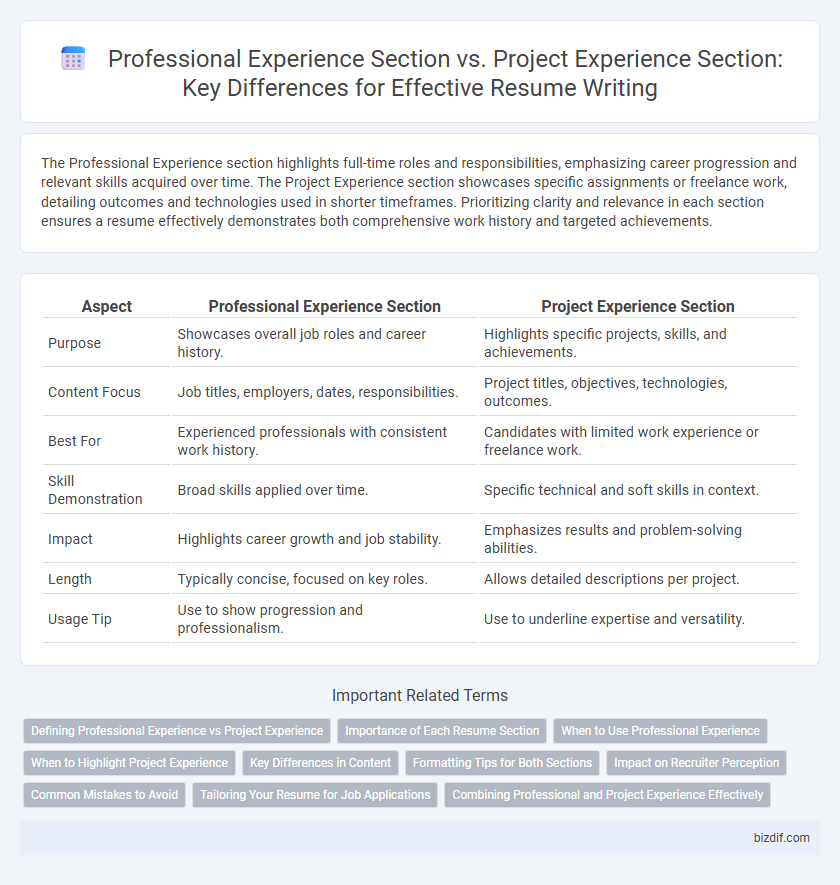The Professional Experience section highlights full-time roles and responsibilities, emphasizing career progression and relevant skills acquired over time. The Project Experience section showcases specific assignments or freelance work, detailing outcomes and technologies used in shorter timeframes. Prioritizing clarity and relevance in each section ensures a resume effectively demonstrates both comprehensive work history and targeted achievements.
Table of Comparison
| Aspect | Professional Experience Section | Project Experience Section |
|---|---|---|
| Purpose | Showcases overall job roles and career history. | Highlights specific projects, skills, and achievements. |
| Content Focus | Job titles, employers, dates, responsibilities. | Project titles, objectives, technologies, outcomes. |
| Best For | Experienced professionals with consistent work history. | Candidates with limited work experience or freelance work. |
| Skill Demonstration | Broad skills applied over time. | Specific technical and soft skills in context. |
| Impact | Highlights career growth and job stability. | Emphasizes results and problem-solving abilities. |
| Length | Typically concise, focused on key roles. | Allows detailed descriptions per project. |
| Usage Tip | Use to show progression and professionalism. | Use to underline expertise and versatility. |
Defining Professional Experience vs Project Experience
Professional Experience section highlights a candidate's long-term roles, responsibilities, and career progression within organizations, emphasizing job titles, durations, and key achievements. Project Experience section focuses on specific, time-bound assignments or initiatives where skills and contributions are demonstrated through concrete outcomes, technologies used, and project goals met. Differentiating these sections allows recruiters to assess both sustained professional growth and targeted expertise effectively.
Importance of Each Resume Section
The Professional Experience section highlights an individual's work history, showcasing job titles, responsibilities, and achievements that demonstrate consistent career growth and industry expertise. The Project Experience section emphasizes specific completed projects, detailing contributions, skills applied, and measurable outcomes, which is especially valuable for candidates with limited formal work history or those in project-driven fields like IT and engineering. Both sections collectively enhance a resume's impact by providing a comprehensive view of a candidate's practical experience and accomplishments tailored to the job requirements.
When to Use Professional Experience
Use the Professional Experience section when detailing roles that demonstrate long-term employment, consistent responsibilities, and career growth within established companies. This section highlights job titles, key achievements, and skills relevant to the position applied for, emphasizing work history and professional development. It is essential for candidates with extensive industry experience and career progression that align with their job target.
When to Highlight Project Experience
Highlight project experience in your resume when applying for roles that require specific technical skills or when your professional experience does not fully demonstrate your capabilities. Project experience showcases hands-on involvement, problem-solving, and deliverables, making it critical for candidates with limited job history or transitioning careers. Including detailed project descriptions with measurable outcomes can effectively illustrate expertise relevant to the target position.
Key Differences in Content
The Professional Experience section highlights an individual's overall job roles, responsibilities, and achievements within various companies, emphasizing long-term career growth and skill development. In contrast, the Project Experience section focuses on specific projects, detailing objectives, methodologies, technologies used, and measurable outcomes to showcase technical expertise and problem-solving abilities. Key differences lie in scope and detail, with Professional Experience providing a broader work history and Project Experience offering targeted insights into particular accomplishments.
Formatting Tips for Both Sections
Use clear headers and consistent formatting to distinguish Professional Experience and Project Experience sections in your resume. Incorporate bullet points highlighting specific achievements, quantifiable results, and relevant skills for each role or project. Align dates, job titles, and company or project names uniformly to enhance readability and ensure ATS compatibility.
Impact on Recruiter Perception
The Professional Experience section highlights consistent career growth and relevant roles, demonstrating reliability and long-term value to recruiters. The Project Experience section emphasizes specific achievements and technical skills, showcasing adaptability and hands-on expertise that align with job requirements. Combining both sections effectively enhances a recruiter's perception by presenting a well-rounded candidate with proven impact and practical abilities.
Common Mistakes to Avoid
Confusing the Professional Experience section with the Project Experience section often results in unclear accomplishments and diluted impact. Avoid listing generic job duties under project details; instead, highlight specific skills, technologies, and outcomes relevant to each project. Failing to tailor these sections to showcase measurable achievements and role-specific contributions can weaken the overall effectiveness of a resume.
Tailoring Your Resume for Job Applications
Tailoring your resume for job applications involves strategically choosing between the Professional Experience Section and the Project Experience Section based on relevance. The Professional Experience Section highlights your consistent work history, emphasizing roles, responsibilities, and achievements aligned with the job description. In contrast, the Project Experience Section showcases specific, impactful projects that demonstrate specialized skills, problem-solving abilities, and measurable outcomes directly related to the targeted position.
Combining Professional and Project Experience Effectively
Combining the professional experience section with project experience in a resume highlights practical skills alongside job responsibilities, making the candidate's expertise more tangible to recruiters. Structuring each entry to include key projects within roles ensures clarity and demonstrates impact with measurable achievements. Tailoring this integrated approach to align with job descriptions increases relevance and improves the overall effectiveness of the resume.
Professional Experience Section vs Project Experience Section Infographic

 bizdif.com
bizdif.com